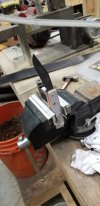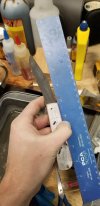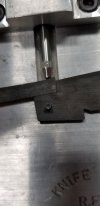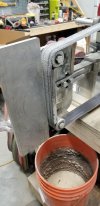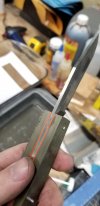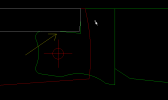- Joined
- Feb 19, 2018
- Messages
- 660
TUTORIAL POST #6
This one will cover getting your handle material ready.
step one is to glue your template to the handle material. my design will allow you to get both handles out of one standard size piece of scale material. Having just completed a knife made of G10 I can say that if you are looking for the easiest material to achieve the best results G10 is it. It grinds and finishes the easiest and it comes pretty much perfectly flat right from the suppliers.
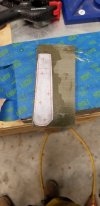
For this build I used a large piece of G10, but if you are using standard sized scales you can print out the templates from my pdf files and glue them to the scale (use the same spray adhesive as before). No need to individually cut out each template. It should be noted that these photos are being made with an updated template. the only difference is that I added 2 more pins and a bolster. For this build those will be ignored. Only the pivot and 2 retaining holes in the backspring are needed. The extra holes are only needed when making a knife with liners.
Using the optical center punch mark the 3 holes in only one of the scales. It is extremely important that these holes are drilled accurately. There is very little wiggle room if they don't line up to the template. If you drill the first scale and the holes are off just throw it away. Trust me, its not worth the headache. use inexpensive handle material to help ease the pain. Prior to drilling use a 123 block to verify that table is square to your bit. All 3 holes will be drilled with a 3/32" bit. Once one scale is completely drilled and you are happy with the placement clamp it on top of your second piece of scale material. you will use the 3 holes you just drilled as a template for the other scale. This removes one source of potential error and ensures at least your scales match perfectly. I like to use 123 blocks to elevate my scales to allow for easy clamping as pictured below. If you do this re verify your table is square after adjusting the height. Notice in the picture I have marked off the 2 holes that do not need to be drilled. This seems simple but it can save you from making a mistake. if you are using my current template this wont be necessary. As you drill each hole place a piece of 3/32" rod through it so the scales don't shift. It may seem that the rod fits really tight or is hard to get in. If this is the case chuck up some rod in cordless drill and turn on your grinder with a 240 grit belt. Spin the rod using the drill against the moving belt for one or two seconds to slightly bring down the diameter, this makes for an easier fit. You can use these rods as assembly pieces for the rest of the build, just don't take too much off or it could affect the final fit up.
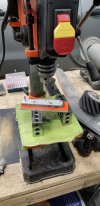
Once both scales are drilled use 2 or 3 pins to secure them together and grind them to their rough shape. I use my platen and work rest to ensure 90 degree edges. use a 123 block to ensure your platen is square. This can be done freehand but you will likely be slightly out of square.
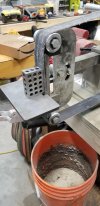
I like to start with an old low grit belt to speed things up. Finish up to a low grit for this stage. This will be refined later.
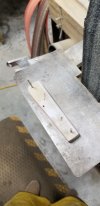
Once complete you will be left with something like this.
This one will cover getting your handle material ready.
step one is to glue your template to the handle material. my design will allow you to get both handles out of one standard size piece of scale material. Having just completed a knife made of G10 I can say that if you are looking for the easiest material to achieve the best results G10 is it. It grinds and finishes the easiest and it comes pretty much perfectly flat right from the suppliers.

For this build I used a large piece of G10, but if you are using standard sized scales you can print out the templates from my pdf files and glue them to the scale (use the same spray adhesive as before). No need to individually cut out each template. It should be noted that these photos are being made with an updated template. the only difference is that I added 2 more pins and a bolster. For this build those will be ignored. Only the pivot and 2 retaining holes in the backspring are needed. The extra holes are only needed when making a knife with liners.
Using the optical center punch mark the 3 holes in only one of the scales. It is extremely important that these holes are drilled accurately. There is very little wiggle room if they don't line up to the template. If you drill the first scale and the holes are off just throw it away. Trust me, its not worth the headache. use inexpensive handle material to help ease the pain. Prior to drilling use a 123 block to verify that table is square to your bit. All 3 holes will be drilled with a 3/32" bit. Once one scale is completely drilled and you are happy with the placement clamp it on top of your second piece of scale material. you will use the 3 holes you just drilled as a template for the other scale. This removes one source of potential error and ensures at least your scales match perfectly. I like to use 123 blocks to elevate my scales to allow for easy clamping as pictured below. If you do this re verify your table is square after adjusting the height. Notice in the picture I have marked off the 2 holes that do not need to be drilled. This seems simple but it can save you from making a mistake. if you are using my current template this wont be necessary. As you drill each hole place a piece of 3/32" rod through it so the scales don't shift. It may seem that the rod fits really tight or is hard to get in. If this is the case chuck up some rod in cordless drill and turn on your grinder with a 240 grit belt. Spin the rod using the drill against the moving belt for one or two seconds to slightly bring down the diameter, this makes for an easier fit. You can use these rods as assembly pieces for the rest of the build, just don't take too much off or it could affect the final fit up.

Once both scales are drilled use 2 or 3 pins to secure them together and grind them to their rough shape. I use my platen and work rest to ensure 90 degree edges. use a 123 block to ensure your platen is square. This can be done freehand but you will likely be slightly out of square.

I like to start with an old low grit belt to speed things up. Finish up to a low grit for this stage. This will be refined later.

Once complete you will be left with something like this.



